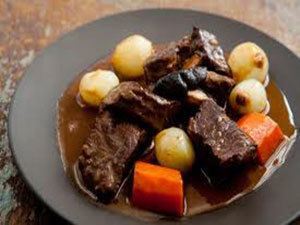My video post yesterday showed me trying to make Julia Child’s Boeuf Bourguignon from the Julia and Julie movie. My contention is that Julie Powell couldn’t have possibly made this complicated dish perfectly the first try. For those of you who’ve followed my blog over the past 18 months, you’ll know this runs directly opposite of everything I’ve taught. You can only learn to cook by following recipes if you’re in a movie.
Let’s keep in mind the time frame that Julia Child brought this recipe to the American public. It was the 1960s. There were a lot more “homemakers” then. Perhaps they had all day long to prepare dinner for when the bread winner came home. Today, most households don’t have a homemaker. Most often, there are two incomes in the home, along with soccer practice, school clubs and many other demands on our time.
My mission is to make cooking simple and enjoyable to those of us with much greater value on our time than 1960s homemakers did. The goal today is to provide wholesome meals to your family with less time and effort. Does this mean that the quality of the food you prepare will naturally suffer? No, it doesn’t, because by focusing on basic cooking methods over a complicated recipe can yield the same, if not better results.
When I look at the Julia and Julie Beef Bourguignon, I see two simple words – braising method. To update this 40 year old recipe, here’s how I’d apply basic cooking methods and creativity to yield beef bourguignon:
1) The many emails I’ve received since yesterday say I was unfair in re-scaling the recipe down to 2 people from 8 servings. Perhaps, but this is an inherent flaw in every recipe. It’s not unfair when I am only feeding 2 people. Cooking by basic methods skips the first step of using a calculator to scale the recipe. From standard portions, I know I need 4 ounces of protein per person, so the only measurement I’ll make is 8 ounces of beef to start.
2) Julia Child’s recipe has me using 5 different pans. This adds to clean-up time. To start, I’d use one pan, my covered 12 inch braising pan.
3) The original recipe calls for beurre manie, and uncooked roux, to thicken the gravy after 2 ½ hours of cooking. Roux without the proteins cooked out of the flour will leave a pasty taste in your gravy. The first change I’d make is dredging the dried beef cubes in flour to start. The combination of flour and fat in my braising pan will yield a cooked roux, and eliminate 2 pans.
4) After browning the dredged meat, I’d add all the vegetables I desire. Whether onions, garlic, carrots, celery, or tomatoes, I get to choose what goes into the dish, and the amount of each. This eliminates a lot of back-and-forth to the recipe book, and another dirtied pan.
5) After sautéing the beef and vegetables, now is the time to deglaze the pan with red wine. This will lift any fond and roux from the bottom of the pan. After all the wine has evaporated, you can start to build the gravy by adding some beef broth.
6) Cover the pan and simmer on the stove top, or place in your oven until the flavors combine, the gravy thickens, the meat tenderizes, and vegetables cook.
That’s how I see this recipe as a basic cooking method that can be accomplished with any substitutions of ingredients, and any amount of ingredients you’d like.
Recipes are a great way to get ideas of what to cook, but an understanding of basic cooking methods are ALWAYS necessary to infuse the skilled judgment of the cook. Cooking with your eyes, ears, nose, and fingers always gives you power over the shortcomings of recipes.
Cook like a chef at home in 16 weeks, guaranteed with my online cooking classes.



Hi Chef Todd, I just came upon your cooking website and all I can say is “Wow, what a breath of fresh air!” I am fascinated by your scientific information and grateful for your time saving tips. Your love of cooking shines through and I thank you for your advice. Please don’t ever stop.
An easy way to cook something like this is in a pressure cooker, all on the stove top. Modern pressure cookers are very safe and relatively quiet. You could probably cook a very tasty version of this dish in about an hour. I did spare ribs tonight in a similar manner as this recipe and it took about an hour. It depends how fast you are in chopping the veggies and how quick your stove heats.
Braising is a combination cooking method that takes advantage of the benefits of saute along with the moist cooking process of poaching.
You’re braising the whole time if you brown the meat first, then add liquid and cook it for a long time under a moist process.
You’ll know when it’s done when the meat is tender, the gravy thickened, and vegetables cooked to your liking.
I realize we havent gone over braising yet. Julia has you braising in the oven for 2.5hrs. Since you mentioned your covered braising pan…you get pan hot cook the beef (dredged in flour) and deglaze after cooking down the veggies. When do you braise and typically for how long?